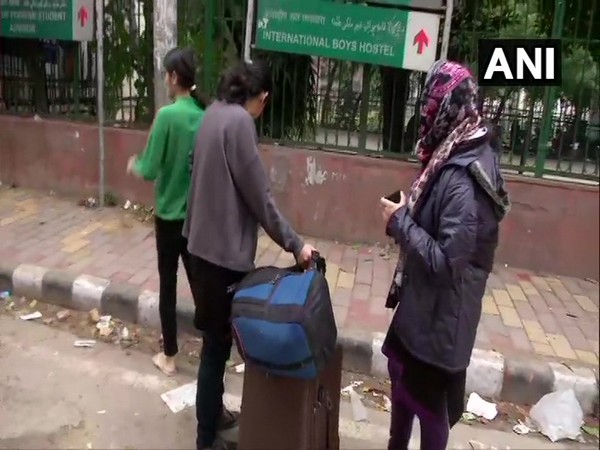Sentiment Analysis on Jamia Protest: Social media decries violent protests and police brutality in same vein
In a Twitter based sentiment analysis conducted by VisionRI on violent protests in South Delhi, the data shows that the Twitter users overwhelmingly decried violent protests as well as police brutality inside the campus of Jamia Millia Islamia University. The sentiment on the role of university administration was highly positive but strongly negative for the government.

- Country:
- India
The violent protest in South Delhi on Sunday and subsequent police brutality on students have converted the Jamia Millia Islamia (JMI) University into an epicenter of students’ protest against the Citizenship Amendment Act (CAA). It was after the brutality on students inside the campus, the protest against CAA spread into the campuses of the other institutions and universities of the country such as Nadwa-tul-Ulema University Lucknow, Jadavpur University West Bengal, IIT Bombay, TISS Mumbai, BHU, MAANU Hyderabad and University of Allahabad etc.
As the student community is prominently using social media to spread awareness about their cause and organizing protests against the CAA, VisionRI attempted to decipher the public mood on the issue by conducting a sentiment analysis through a scientifically proven methodology. In this exercise 19,400 tweets posted on two hashtags #JamiaProtest and #JamiaMilia on 15-16 December were analyzed. The analysis has provided some insights into the issue which are often lost in high pitched prime time media debates.
Thumbs down to violence and brutality
The analysis shows that the Twitter users in both the hashtags overwhelmingly decried violence caused by protestors as well as police brutality on students. In both the hashtags, the words ‘brutal’ and ‘brutality’ featured among the top ten words used to express anger, negativity and fear. Besides, the word ‘violent’ is the first among the top ten words used to express anger and surprise. It is also among the top ten words used by Twitter users to express sentiments of negativity and fear.
Though the police are blamed for brutality in the campus, the word ‘police’ has not been used prominently by Twitter users to express sentiments. Here, the word ‘government’ comes on the top in receiving the negative sentiment while ‘university’ is on the top on positive sentiment. Besides the government, the other words used to express negative sentiment are – ‘brutality’, ‘violent’, ‘attack’, ‘force’, ‘injured’, ‘brutal’, ‘fight’, ‘wrong’, and ‘hate’. The word ‘force’ which seems to represent police or security forces also featured on 3rd rank in expressing anger and 7th on fear.
The analysis indicates that the role of the JMI administration in crisis management was highly appreciable. The university administration also succeeded in holding the confidence of students through timely interventions with properly designed communication and well-articulated position. On the other hand, the government agencies, besides their failure in getting confidence of students in Jamia, seem losing the confidence of students across the campuses throughout the country.
Highly Positive on Democracy
We noticed highly positive sentiment for the word ‘democracy’ which indicates people’s confidence in democratic processes and the democratic right of peaceful protests. The word democracy is the top most word to express positive sentiment at #JamiaMilia while second at #JamiaProtest. The Twitter users have expressed very high degree of hope and expectation on peaceful protests in democracy.
In expressing anticipation, the word ‘peaceful’ was ranked on the top at #JamiaMilia while 2nd at #JamiaProtest. Besides, the word ‘peace’ also featured among the top six words in expressing anticipation in both the hashtags. The word ‘peaceful’ is also among the top ten words used to express positivity, trust and joy. In addition, the Twitter users have also expressed a high degree of hope on ‘secular’ credentials of India and trust in the rule of ‘law’.

Twitter users believe in innocence of students
The sentiment analysis shows that the Twitter users were largely convinced on the argument that the students who faced police brutality were innocent. This is because the word ‘innocent’ has featured among top ten words in both the hashtags used to express trust. Besides, the word ‘attack’, primarily used for attack on students, is among the top ten words on both the hashtags for expressing anger, sadness, fear, disgust, surprise and negative sentiments.
The opinions expressed on Twitter were vindicated in the police action as out of the 10 persons arrested by police on Tuesday in connection to the Sunday’s violence, none of them was a student of JMI.
METHODOLOGY
The sentiment analysis is based on the data extracted from Twitter hashtag #JamiaProtest and #JamiaMillia. In the exercise 19,400 tweets (9,800 from #JamiaProtest and 9,600 from #JamiaMillia), posted on these two hashtags on 15-16 December, 2019 were extracted by using API (application programing interface). The extracted tweets were subjected through three methods of natural language processing – BING lexicon, NRC lexicon and AFINN lexicon – for sentiment analysis.
Research Team: J.P. Singh, Editor-in-Chief, Neeraj Singh Mehta, Technical Lead, Esham Chatterjee, Assistant Manager - Economic Studies and Planning, Siddheshwar Shukla, Associate Editor, and Senior Sub-Editors, Parag Narang and Subhro Prakash Ghosh.
Disclaimer: The conclusions drawn in the sentiment analysis are subject to technological limitations of data extraction and methodology(ies) used for data processing. This study is based on analysis of tweets only and the retweets were not taken into account. All the available precautions have been made to maintain the objectivity of the research and its presentation in a scientific fashion.
- READ MORE ON:
- Sentiment Analysis on Jamia Protes
- Sentiment Analysis
- Jamia Protest
- Social media
- violet protests
- police brutality
- Citizenship Amendment Act
- CAA
- Jamia Millia Islamia
- Nadwa-tul-Ulema University
- MAANU Hyderabad
- University of Allahabad
- BHU
- TISS Mumbai
- Jadhavpur University
- #JamiaProtest
- #JamiaMilia
- violence and brutality
- JMI administration
- innocence
- FIRST PUBLISHED IN:
- Devdiscourse

 Devdiscourse News Desk
Devdiscourse News Desk









